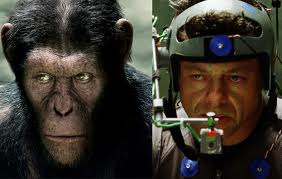Motion-capture technology plays an important part in the production of films like The Hobbit. In recent weeks Andy Serkis has talked about how developments in the technology means he plays Gollum on a live-action set in The Hobbit and so is able to interact with the other actors. There has also been a fascinating video circulating, which shows a scene from The Rise of the Planet of the Apes before and after the special effects were added.
Now, in an interview with the New York Times, Joe Letteri of Weta Digital has told how motion-capture technology has advanced since the days of The Lord of the Rings. He was unable to say much about The Hobbit but talked about filming Caesar, played by Serkis, in The Rise of the Planet of the Apes.
“What we did differently for this one [Rise of the Planet of the Apes] is, we wanted to capture Andy’s performance on the set. Back when we started doing this with Gollum on “Lord of the Rings” in ’99, 2000, we could have Andy on the set but we couldn’t record his motion on the set. He’d perform but then he had to go to a motion-capture set, and he’d do it again. [He had to do everything twice] through all the “Lord of the Rings” films and through “King Kong.”
… what we did is change the suits so that we could use them on the set; rather than have reflective markers, we put active LEDs on the shoot. We rigged our cameras so they were part of the normal rigging…He didn’t have to go back and redo any of his performance, we did the same kind of facial rig setup that we had for “Avatar” so we could get his reactional performance.”
Asked how the new technology helped him Letteri said, “…Everything was shot as a normal movie, it’s just that as the post-production goes on, we start replacing images of Andy with animated images of Caesar.
The technology really helps you get things done faster and better but in the end, because there’s all this hand work that has to go into it anyway, to fine-tune it, we do all of that, and have done all of that for years… The computer is a tool, it’s a very sophisticated tool but there’s still a human eye that has to look over everything and make sure it’s right. Everything is still done by eyes essentially. It’s one of the secrets of the business, that there’s still quite a lot of that that goes on.
You’re taking a human body and fitting it into a different sized skeleton and a different kind of posture and a different gait. So there’s a basic translation that you can do, but it won’t get you the things that make it believable — the weight of a knuckle on a ground, or when he scratches his face. For a computer that makes it, it wants to make that repeat the same way. [But] humans don’t ever repeat the same motion the same way. There’s always going to be an artistic side to it.”
“The motion capture is in a way the easiest part,” Mr Letteri said, “Translating the performance that maintains everything that was intended by the real performance — that’s the hard part. It’s a very human-involved process as opposed to a mechanical process of capturing motion.”


